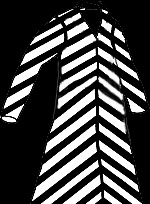 |
 |
 |
 |
 |
 |
STRIPES |
military
insignia weaving flags |
>
lashes > garments > letters |
|
FABRIC |
TRIBE |
SEMIOTOC
|
key words: symbol semiotic fabric
THE LANGUAGE
OF FASHION SYMBOLS
http://www.orst.edu/instruct/aihm577/intro9.htm, http://www.orst.edu/instruct/aihm577/ft9.htm
I would, to begin with, hold that clothing styles and the fashions that influence them over time constitute something approximating a code. It is a code, however, radically dissimilar from those used in cryptography; neither can it, more generally, be equated with the language rules that govern speech and writing.
Codpieces
to Spoonerisms: Semiolinguistic Approaches to Communication in Culture
http://www.csun.edu/~vcspc005/codpie92.html
... Doth apparel
the symbol make? A semiotic investigation of symbolic references to
dress in selected ... The fabric's the thing: Literal and figurative references
to ...
The Visual
Texts in Timeless Tradition
http://ignca.nic.in/nl_01004.htm
Stripes
associated with Slavery in the Roman Republic inflicting stripes (40)
lashes?
http://www.fordham.edu/halsall/ancient/slavery-romrep1.html
The horsemen wore their 'dress uniforms', as if coming home victorious from battle: wearing olive branches on their heads and purple robes with scarlet stripes; stripes and bars - a strip of material that is sewn onto the arm of a military uniform to show the rank of the person wearing it.
Both
uses of stripes indicated in shakespeare:
shakespeare keyword:
stripes > search results
Whom stripes may move, not kindness! I have used thee, The Tempest: I, ii
Who wears my stripes impress'd upon him; that Coriolanus: V, vi
Than the stripes I have received, which are mighty The Winter's Tale: IV, iii
Hence with thy stripes, begone! Antony and Cleopatra: III, xiii
A many-colored
coat (37:3)
http://www.simplyjewish.com/Pages_SJ2001/SJ2001_Library/2001_TorahStudy/T4Q2001_Genesis.html
Ketonet passim, in the Hebrew. The word passim can be translated as
"colorful" (Radak; Septuagint),
"embroidered" (Ibn Ezra; Bachya; Nachmanides on Exodus 28:2),
"striped" (Ibn Janach; Radak, Sherashim), or
"illustrated" (Targum Yonathan). It can also denote
a long garment, coming down to the
"palms" of the hands (Rashbam; Ibn Ezra; Baaley Tosafoth; Midrash Rabbah), and the
feet (Lekach Tov). Alternatively, the word denotes the material out of which the
coat was made, which was
fine wool (Rashi) or
silk (Ibn Janach). Hence,
Ketonet passim, may be translated as
"a full-sleeved robe,"
"a coat of many colors,"
"a coat reaching to his feet,"
"an ornamented tunic,"
"a silk robe," or
"a fine woolen cloak."
Hebrew phrase lech lecha (Go/lech toward yourself or for yourself/lecha)
suggesting that this journey may be an inner as well as an outer one.
http://www.chabadonline.com/scripts/tgij/paper/Articlecm.asp?ArticleID=2673
| |||| Ketonet Passim: "What Joseph Wore" |||| |



